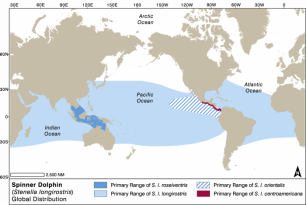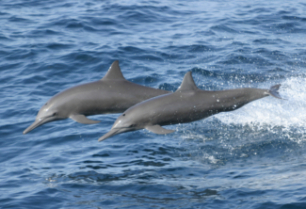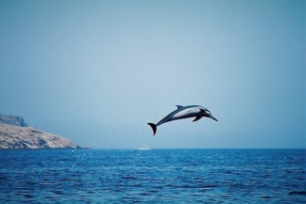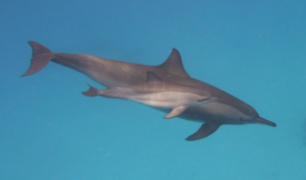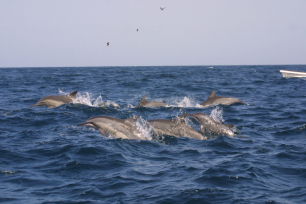Although most commonly found in offshore waters, some spinner dolphin populations also use nearshore areas. Here they are a great favourite of dolphin watching tours, because of their impressive acrobatics, which include leaps and body slaps, as well as their unique penchant for spinning. They are able to spin on their lateral axis – making up to 7 full rotations in one leap. There are four recognized subspecies of spinner dolphins throughout the species’ tropical range: Gray’s spinner dolphin (Stenella longirostris longirostris) which is the most common form distributed throughout the range; the Eastern spinner dolphin (S.l. orientalis) which occurs in the Eastern Tropical Pacific off the coasts of South and Central America; the central American spinner dolphin (S.l. centroamericana), found only in a narrow strip of habitat along the west coast of central America; and the Dwarf spinner dolphin (S.l. roseiventris) which is found only in southeast Asia and northern Australia1,2. There is also a large population of whitebelly spinner dolphins, which are a hybrid form S. l. longirostris X S. l. orientalis.
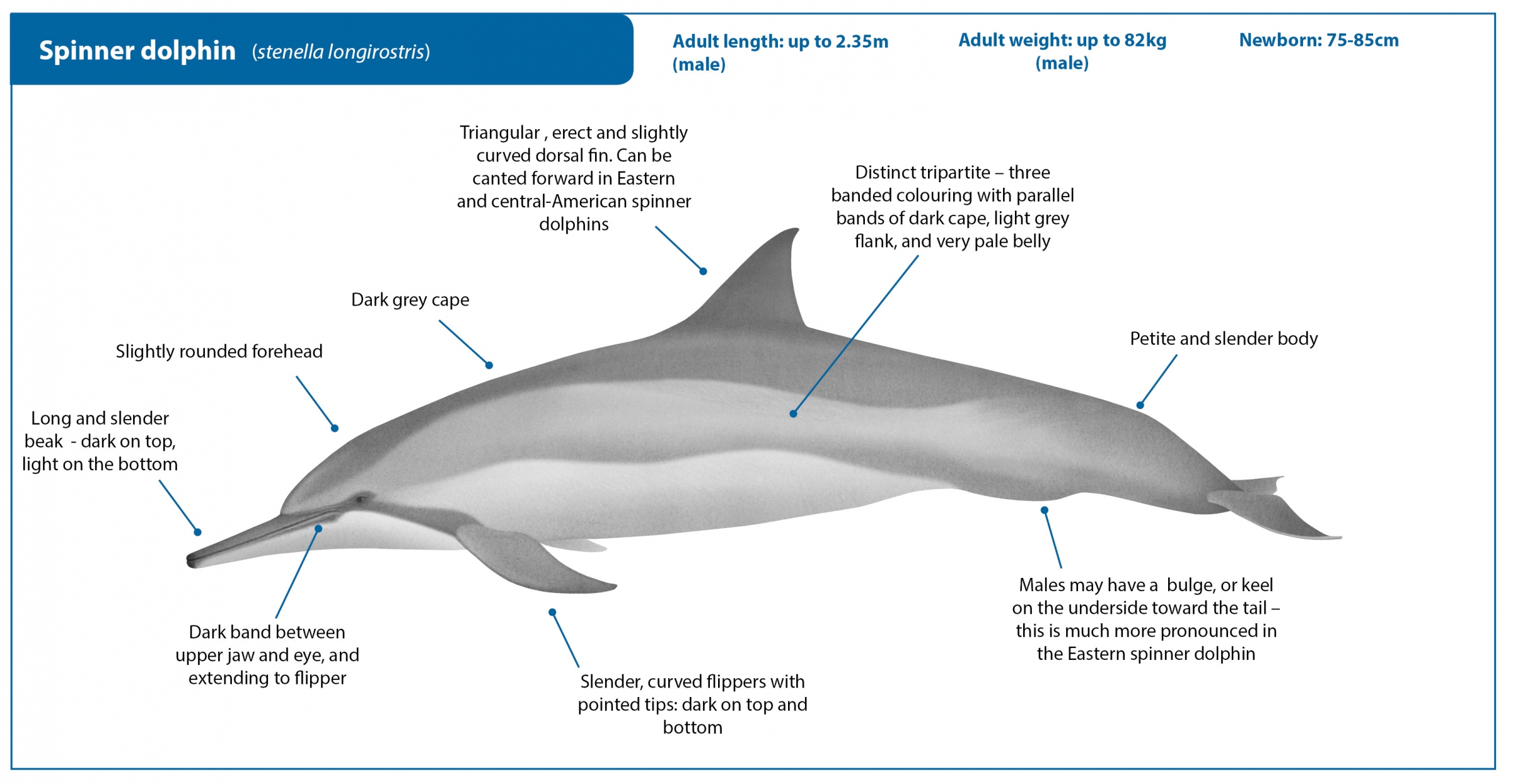
References
Show / Hide References
- Jefferson, T.A., M.A. Webber, and R.L. Pitman, Marine Mammals of the World: a Comprehensive Guide to their Identification. Second Edition. 2015: San Diego: Academic Press.
- Committee on Taxonomy, List of marine mammal species and subspecies. Society for Marine Mammalogy, www.marinemammalscience.org, consulted on 11 October 2017. 2017.
- Perrin, W., F., Stenella longirostris. Mammalian Species, 1998. 599: p. 1-7.
- Bearzi, G., et al., Stenella longirostris, in The IUCN Red List of Threatened Species. . 2012, http://www.iucnredlist.org/det... Consulted October 2017.
- Benoit-Bird, K.J. and W.W.L. Au, Prey dynamics affect foraging by a pelagic predator (Stenella longirostris) over a range of spatial and temporal scales. Behavioral Ecology and Sociobiology, 2003. 53: p. 364-373.
- Ponnampalam, L., et al., Feeding ecology of small cetaceans in the Sultanate of Oman. Poster presented at the 17th meeting of the Society for Marine Mammals in Cape Town, 2007.
- Ballance, L.T., R.L. Pitman, and P.C. Fiedler, Oceanographic influences on seabirds and cetaceans in the eastern tropical Pacific: A review. Progress in Oceanography, 2006. 69: p. 360-390.
- Perrin, W.F., Spinner dolphin Stenella longirostris, in Encyclopedia of Marine Mammals. Second Edition, W.F. Perrin, B. Würsig, and J.G.M. Thewissen, Editors. 2009, Academic Press: San Francisco. p. 1100-1103.
- Querouil, S., et al., Why do dolphins form mixed-species associations in the Azores? Ethology, 2008. 114: p. 1183–1194.
- Wade, P., Revised estimates of incidental kill of dolphins (Delphinidae) by the purse-seine tuna fishery in the eastern tropical Pacific, 1959-1972. Oceanographic Literature Review, 1996. 1(43): p. 69.
- Gerrodette, T. and J. Forcada, Non-recovery of two spotted and spinner dolphin populations in the eastern tropical Pacific Ocean. Marine Ecology Progress Series, 2005. 291: p. 1–21.
- Edwards, E.F., Fishery Effects on Dolphins Targeted by Tuna Purse-seiners in the Eastern Tropical Pacific Ocean. International Journal of Comparative Psychology, 2007. 20: p. 217-227.
- Hammond, P.S., et al., Stenella longirostris ssp. orientalis, in The IUCN Red List of Threatened Species. Version 2014.3. 2012, http://www.iucnredlist.org/det... Consulted October 2017.
- Ponnampalam, L.S., Dolphin Watching in Muscat, Sultanate of Oman: Tourist Perceptions and Actual Current Practice. Tourism in Marine Environments, 2011. 7(2): p. 81-93.
- Courbis, S. and G. Timmel, Effects of vessels and swimmers on behavior of Hawaiian spinner dolphins (Stenella longirostris) in Kealake‘akua, Honaunau, and Kauhako Bays, Hawai‘i. Marine Mamal Science, 2009. 25(2): p. 430-440.
- Danil, K., D. Maldini, and K. Marten, Patterns of use of Maku'a Beach, O'ahu, Hawai'i, by dolphins (Stenella longirostris) and potential effects of swimmers on their behavior. Aquatic Mammals, 2006. 31(4): p. 403-412.
- Timmel, G., et al., Effects of human traffic on the movement patterns of Hawaiian spinner dolphins (Stenella longirostris) in Kealakekua Bay, Hawaii. Aquatic Mammals, 2008. 34(4): p. 402.
- Notarbartolo di Sciara, G., et al., Spinner dolphin (Stenella longirostris) resting habitat in Samadai Reef (Egypt, Red Sea) protected through tourism management. Journal of the Marine Biological Association of the United Kingdom, 2008. 89(1): p. 211-216.

